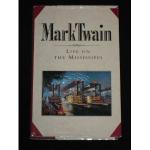How solemn and beautiful is the thought, that the earliest pioneer of civilization, the van-leader of civilization, is never the steamboat, never the railroad, never the newspaper, never the Sabbath-school, never the missionary—but always whiskey! Such is the case. Look history over; you will see. The missionary comes after the whiskey—I mean he arrives after the whiskey has arrived; next comes the poor immigrant, with ax and hoe and rifle; next, the trader; next, the miscellaneous rush; next, the gambler, the desperado, the highwayman, and all their kindred in sin of both sexes; and next, the smart chap who has bought up an old grant that covers all the land; this brings the lawyer tribe; the vigilance committee brings the undertaker. All these interests bring the newspaper; the newspaper starts up politics and a railroad; all hands turn to and build a church and a jail—and behold, civilization is established for ever in the land. But whiskey, you see, was the van-leader in this beneficent work. It always is. It was like a foreigner— and excusable in a foreigner—to be ignorant of this great truth, and wander off into astronomy to borrow a symbol. But if he had been conversant with the facts, he would have said—
Westward the Jug of Empire takes its way.
This great van-leader arrived upon the ground which St. Paul now occupies, in June 1837. Yes, at that date, Pierre Parrant, a Canadian, built the first cabin, uncorked his jug, and began to sell whiskey to the Indians. The result is before us.
All that I have said of the newness, briskness, swift progress, wealth, intelligence, fine and substantial architecture, and general slash and go, and energy of St. Paul, will apply to his near neighbor, Minneapolis—with the addition that the latter is the bigger of the two cities.
These extraordinary towns were ten miles apart, a few months ago, but were growing so fast that they may possibly be joined now, and getting along under a single mayor. At any rate, within five years from now there will be at least such a substantial ligament of buildings stretching between them and uniting them that a stranger will not be able to tell where the one Siamese twin leaves off and the other begins. Combined, they will then number a population of two hundred and fifty thousand, if they continue to grow as they are now growing. Thus, this center of population at the head of Mississippi navigation, will then begin a rivalry as to numbers, with that center of population at the foot of it—New Orleans.
Minneapolis is situated at the falls of St. Anthony, which stretch across the river, fifteen hundred feet, and have a fall of eighty-two feet—a waterpower which, by art, has been made of inestimable value, business-wise, though somewhat to the damage of the Falls as a spectacle, or as a background against which to get your photograph taken.
Thirty flouring-mills turn out two million barrels of the very choicest of flour every year; twenty sawmills produce two hundred million feet of lumber annually; then there are woolen mills, cotton mills, paper and oil mills; and sash, nail, furniture, barrel, and other factories, without number, so to speak. The great flouring-mills here and at St. Paul use the ‘new process’ and mash the wheat by rolling, instead of grinding it.




